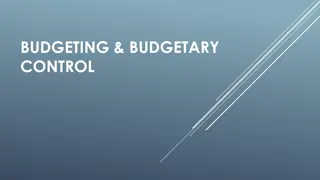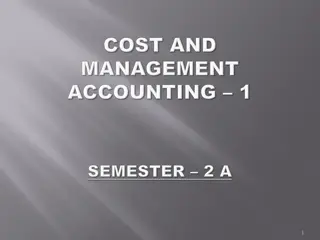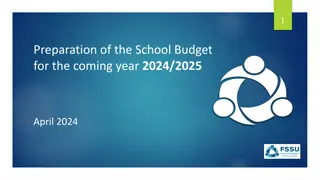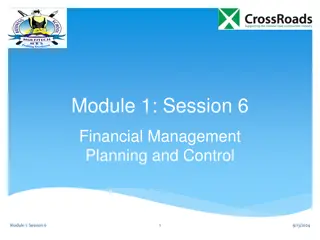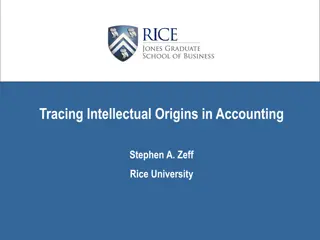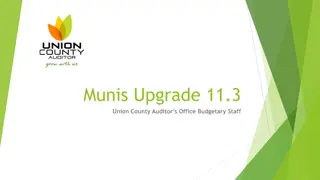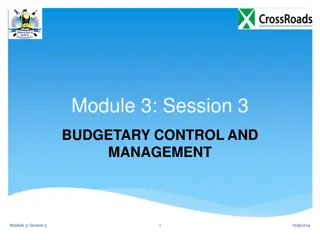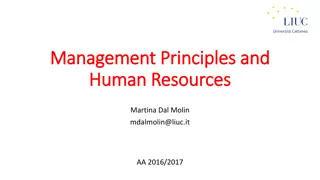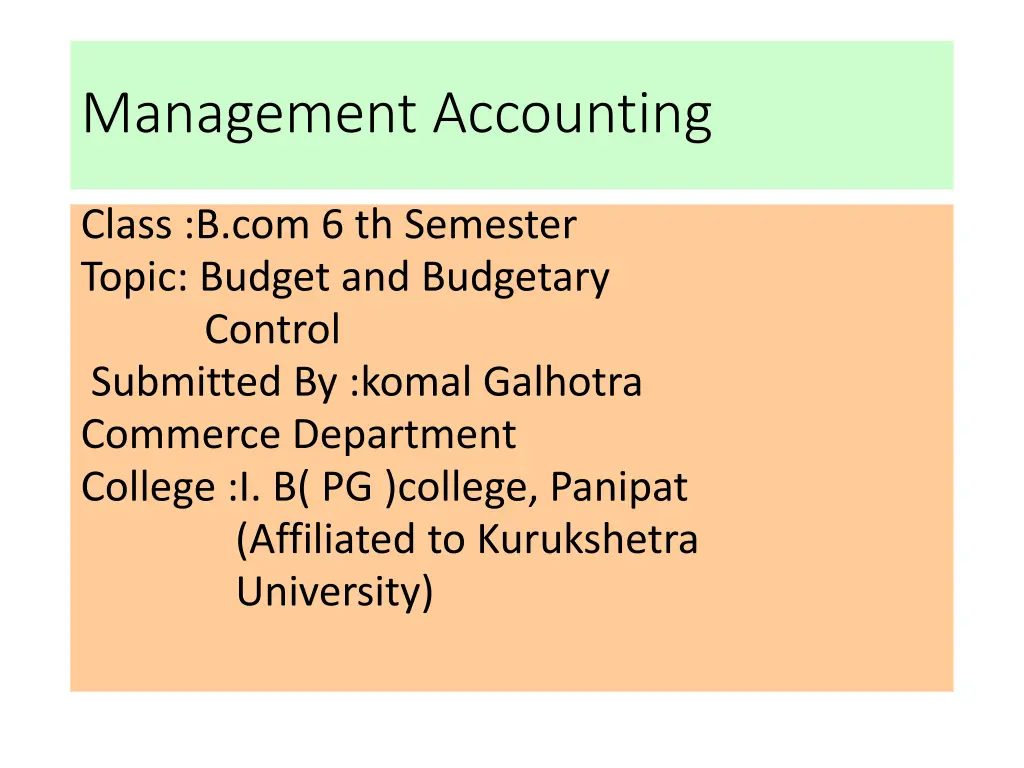
Understanding Budget and Budgetary Control
Explore the significance of budgetary control in management accounting, its objectives, features, and importance in resource utilization and deviation detection. Learn how budgeting aids in planning, coordination, and efficient resource allocation for organizational success.
Download Presentation

Please find below an Image/Link to download the presentation.
The content on the website is provided AS IS for your information and personal use only. It may not be sold, licensed, or shared on other websites without obtaining consent from the author. If you encounter any issues during the download, it is possible that the publisher has removed the file from their server.
You are allowed to download the files provided on this website for personal or commercial use, subject to the condition that they are used lawfully. All files are the property of their respective owners.
The content on the website is provided AS IS for your information and personal use only. It may not be sold, licensed, or shared on other websites without obtaining consent from the author.
E N D
Presentation Transcript
Management Accounting Class :B.com 6 th Semester Topic: Budget and Budgetary Control Submitted By :komal Galhotra Commerce Department College :I. B( PG )college, Panipat (Affiliated to Kurukshetra University)
Budget and Budgetary Control A plan of how to spend an amount of money over a particular period of time. A budget is a tool that helps managers in both planning and control functions .It deals with what managers plan for the future.
Meaning of Budgetary control It is a tool of management control and accounting which directs and coordinates the operations on the basis of budget. It is a process of finding out what is being done and comparing actual results with the budget and finding out the deviations and take a corrective action.
To eliminate wastes and increase profitability. To coordinate various activities like production, sales, purchase of materials etc. To ensure the best use of all the available resources. To provide a basis for comparison of actual performance with target and find out the variance. Objectives Of Budgetaryc ontrol
Features of Budgetary Control planning :Budgetary Control involves preparation of plans for various business activities for a definite period of time. Recording :Budgetary control requires recording of actual performance,its Comparison with budget and analyse the deviations. Specific period :A budget is always prepared for specified period of time usually one year. Financial terms: Budgets are prepared in financial terms like in terms of monetary value.
Importance of Budgetary control : Effective utilisation of Resources : Through budgetary control effective utilisation of resources like men, material, machinery and money is possible. This is because production is planned after taking in to account these resources . Find Deviations : It is an instrument which reveals the deviations to management from the budgeted figures after making comparison with actual figures.
*Planning:Budget are the part of the planning process. It helps the managers to anticipate and forcast the trends and changes in the external environment. Coordination :Budgets are prepared for the different activities of an organisation so as to take care of situation and problems of each activity.So ,it brings coordination. Communication :Budgeting helps to communicate others about the goals and methods selected by top management. So, budget is a means or way of communicating to the employees the level of performance expected.
Limitation of Budgetary control Expensive :The implementation of budgetary control system is very expensive. This is so because it requires proper organisation structure which add to the cost of organisation. Changing situations :Business operate in an environment where changes are continuously taking place. Therefore, it becomes difficult to prepare a perfect budget.
Not a substitute :Budget is only a management tool and must be applied correctly for management to get benefitted. Based on estimates : Budgets are based on series of estimates which are based on the condition prevailing or expected at the time of preparation of budget. If changes in condition take place ,the budget need to be revised.
Difference between fixed and flexible Budget Fixed Budget It operate on one level of activity. It does not change with actual volume activity. comparison of actual performance with budgeted is not possible. Flexible Budget It operate on different levels of activity. it can be changed as per the circumstances. It provides a basis of comparison of actual with budgeted figures.
Types of Budget 1_on the basis of funtions : A : Production Budget :It is a forcast of the production for budget period shows the production for the budget based on sales budget, production, policy. B : Sales Budget :It is a forcast of total sales which is expressed in terms of money and quantity.
C_Material Budget:It specify the budgeted quantities of each raw materials required for the budgeted production. D_ labour Budget :This budget presents an estimate of direct labour essential to meet the production targets fixed in production budget. E_Master Budget: It is a summary of all the subsidiary budget and normally comprised of profit and loss account, balance sheet and cash flow statement .
On the basis of period : A: Long term budget :This type of budget are related with long term planning of the business. The period of this is between 5 to 10 years. B_Short term Budget:This budget is prepared for period of one to five years. C_ Current Budget: This budget is related to Current conditions and may be of few months or weeks.
On the basis of flexibility Fixed Budget : It is a budget which does not Change due to change in level of actual production. Flexible Budget :It is a budget which can be changed according to the changes in business situations.
Other Budgets Zero Base Budget :It is a budget in which all the activities are revalued each time and a budget is set. Performance Budget :It is technique of presenting budgets for cost and revenues in terms of funtions.







